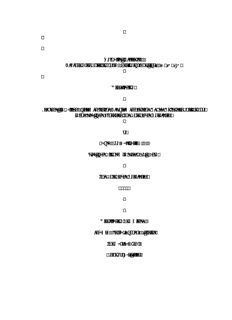
Uncharted Territory: Receptions of Philosophy in Apollonius Rhodius' Argonautica PDF
Preview Uncharted Territory: Receptions of Philosophy in Apollonius Rhodius' Argonautica
Uncharted Territory: Receptions of Philosophy in Apollonius Rhodius’ Argonautica Dissertation Presented in Partial Fulfillment of the Requirements for the Degree Doctor of Philosophy in the Graduate School of The Ohio State University By Laura Ann Marshall, B.A. Graduate Program in Greek and Latin The Ohio State University 2017 Dissertation Committee: Benjamin Acosta-Hughes, Advisor Thomas Hawkins Anthony Kaldellis Copyrighted by Laura Ann Marshall 2017 Abstract The Argonautica of Apollonius Rhodius is often studied in terms of how the author uses previous literary poets such as Homer. This project asks whether Apollonius Rhodius also uses philosophical authors in his Argonautica and looks particularly at Empedocles, Parmenides, Xenophanes, and Plato. In addition to building on references by earlier scholars such as Malcolm Campbell, I use plagiarism-tracking software (WCopyFind) to identify places of potential connection and then evaluate the passages in question to see whether these connections are significant. I conclude that Apollonius does use the works of Empedocles and Parmenides and perhaps Xenophanes, and he uses Parmenides’ and Empedocles’ works in ways that indicate he is interested in their ideas as well as vivid images and rare words. I conclude that although there are good reasons for considering Plato’s works as a source of interest for Apollonius, Apollonius does not use Plato’s work in the same significant ways that he uses Empedocles’ and Parmenides’ works. Instead, Apollonius’ project as a poet-scholar contradicts many of the views on poetry, inspiration and skill that Plato’s Socrates develops in the Ion. The works of Empedocles and Parmenides provide an alternative model of poetry that involves thoughtful mixing of elements from previous poets. ii Dedicated to my mother, Mary Ellen Day Marshall, who parented with skill, determination, and great love. iii Acknowledgments First, I would like to thank Benjamin Acosta-Hughes, whose kindness and patience have helped bring this project to completion. I would also like to thank Tom Hawkins and Anthony Kaldellis for their advice and guidance on a variety of topics and David Noe for kindling my initial interest in Classics. Thanks are also due to Erica Kallis and the graduate students at the Ohio State University Department of Classics (past and present) for their friendship, and to my siblings Leah, Wesley, Grant, Elena, Stuart, and Cameron for their support. iv Vita 2003................................................................Redeemer Academy 2009................................................................B.A. Literature, Patrick Henry College 2009 to present ..............................................Graduate Teaching Associate, Department of Classics, The Ohio State University Publications “Tracking Down Love: A New Interpretation of κεχρηµένος in Callimachus 31.3.” Studi Italiani di Filologia Classica, 2015.2, 227-231. Fields of Study Major Field: Greek and Latin v Table of Contents Abstract...............................................................................................................................ii Acknowledgments..............................................................................................................iv Vita......................................................................................................................................v List of Tables.....................................................................................................................xi List of Figures...................................................................................................................xii Chapter 1: Questions and Methodology.............................................................................1 Background on Apollonius as Scholar and Reader.......................................................10 A New Tool: WCopyFind.............................................................................................17 Step 1: prepare the texts.............................................................................................22 Step 2: run the analysis..............................................................................................24 Step 3: use the TLG to determine word rarity and significance................................35 Step 4: Campbell’s work as a test case......................................................................36 Limitations....................................................................................................................38 Chapter 2: Empedocles.....................................................................................................45 1. Empedocles G20 (B2) and Arg. 1.1291, 4.656, 4.140..............................................48 vi 2. Empedocles G22 (B110) and Arg. 2.1275, 3.765.....................................................53 3. Empedocles G25 (B115) and Arg. 1.647-8, 4.1744-5, 4.587, 1.773.........................54 4. Empedocles G36 (B12) and Arg. 4.1307-8...............................................................68 5. Empedocles G44 (B20) and Arg. 4.1291..................................................................71 6. Empedocles G45 (B21) and Arg. 4.31, 4.1737.........................................................72 7. Empedocles G46 (B22), G41 (B17), the Strasbourg Papyrus and Arg. 1.496-8.......74 8. Empedocles G41 (B17) and Arg. 1.773, 2.685, 2.389..............................................86 9. Empedocles G47 (B23) and Arg. 1.52, 4.933, 2.27..................................................87 10. Empedocles G51 (B35) and Arg. 2.656, 3.177, 4.646, 3.759.................................95 11. Empedocles G55 (B27) and G56 (B28) and Arg. 3.135-8....................................101 12. Empedocles G57 (B29) and Arg. 1.1264-1270, 4.779..........................................105 13. Empedocles G76 (B48) and Arg. 3.1021 and 4.1170............................................110 14. Empedocles G79 (B43) and Arg. 4.1604..............................................................111 15. Empedocles G93 (B52) and Arg. 4.535-6.............................................................112 16. Empedocles G115 (B98) and Arg. 2.980..............................................................114 17. Empedocles G125 (B62) and Arg. 3.1-3, 4.672, 1423..........................................116 18. Empedocles G127 (B100) and Arg. 3.1204, 4.871, 1545.....................................125 19. Empedocles G182 (B121), G50 (B26) and Arg. 3.1275.......................................128 20. Empedocles G185 (B124) and Arg. 4.446............................................................131 vii 21. Empedocles G197 (B136.2) and Arg. 3.297-8......................................................133 22. Empedocles G198 (B137) and Arg. 4.875............................................................136 23. Empedocles’ Elements: G26, G46, G41 (B6, B22, B17) and Arg. 3.207-8, 163-6 .....................................................................................................................................138 24. Empedocles G199 (B138) and Arg. 3.1015 (Dubious).........................................140 25. Empedocles G173.3 (B111.3) and Arg. 3.892 (Unconvincing)............................142 Conclusions.................................................................................................................143 Chapter 3: Parmenides....................................................................................................149 Gates of Night and Daughters of Helios: Parmenides G10 (B1) and Arg. 4.603-630 152 Skillfully: Parmenides G10.16 (B1.16) and Arg. 1.1021, 1.1336, 2.1134, 3.83.........157 There is a Path: Parmenides G11.4 (B2.4), 15.9 (G6.9) and Arg. 2.353, 3.160..........162 Backward-turning: Parmenides G15.9 (B6.9) and Arg. 3.1157, 4.643.......................167 Helplessness: Parmenides G15.7 (B6.7) and Arg. 1.638, 286-89, 2.860-863.............172 Homer, Parmenides, and Apollonius...........................................................................183 Conclusions.................................................................................................................187 Chapter 4: Xenophanes...................................................................................................193 Xenophanes’ Life and Legacy.....................................................................................194 Lasting Songs: Xenophanes G17 (B6) and Arg. 1.25.................................................201 At the Feet: Xenophanes G52 (B28) and Arg. 1.694, 2.61.........................................205 viii Other Possibilities.......................................................................................................207 The Form of the God(s)...............................................................................................211 Theology and Progress................................................................................................213 Conclusions.................................................................................................................221 Chapter 5: The Possibility of Plato.................................................................................223 The Plane Tree(s): Phaedrus 230b and Arg. 2.733.....................................................236 Swan Songs: Phaedo 84e-85a and Arg. 4.1301..........................................................241 Tyrants, Kings, and Leaders........................................................................................245 Conclusions.................................................................................................................248 Chapter 6: Mixing Metaphors: Apollonius, Early Philosophy, and Poetry....................250 Ways of Reading Apollonius......................................................................................250 1. The Word Miner Theory......................................................................................251 2. The Variety Theory.............................................................................................254 3. The Esoteric Theory............................................................................................259 4. The Didactic Poet Theory....................................................................................260 5. The Realism Theory............................................................................................263 6. The Primordial Theory........................................................................................268 7. The Hexameter Theory........................................................................................270 8. The Cultural Continuity Theory..........................................................................271 ix
Description: